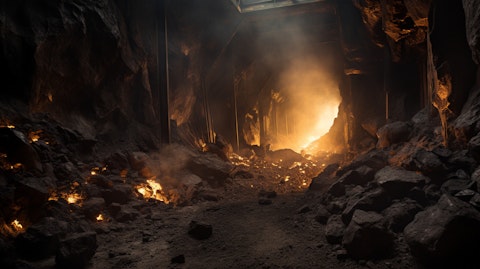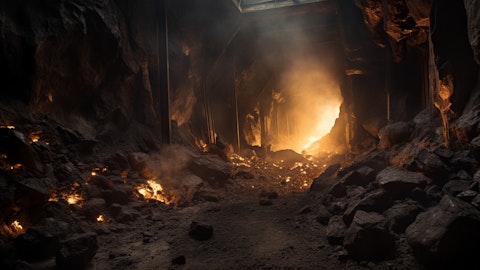Hallador Energy Company (NASDAQ:HNRG) Q4 2023 Earnings Call Transcript March 14, 2024
Hallador Energy Company isn’t one of the 30 most popular stocks among hedge funds at the end of the third quarter (see the details here).
Operator: Hello, and welcome to the Hallador Energy Company’s Announces Fourth Quarter 2023 Earnings Call. My name is Harry, and I’ll be your coordinator today. [Operator Instructions]. Now I’d now like to turn the call over to Becky Palumbo, Investor Relations, to begin. Please go ahead.
Becky Palumbo: Thank you, Harry. Good morning, [indiscernible] Hallador Energy’s call for the fourth quarter and full year 2023 [indiscernible] today are Brent Bilsland, our President and CEO; and Larry Martin, our CFO. Yesterday afternoon, Hallador released its fourth quarter and full year 2023 financial — in a press release. Today, we will discuss those results as well as our perspective on current market conditions and outlook for 2024. Following our prepared remarks, we will open the call to answer your questions. Before beginning, a reminder that some of our remarks today may include forward-looking statements subject to a variety of risks, uncertainties and assumptions contained in our filings from time-to-time with the Securities and Exchange Commission and are also reflected in yesterday’s press release.
While these forward-looking statements are based on information currently available to us, if one or more of these risks or uncertainties materialize or if our underlying assumptions prove incorrect, actual results may vary materially from those we projected or expected. In providing these remarks, Hallador has no obligation to publicly update or revise any forward-looking statements, whether as a result of new information, future results or otherwise, unless [indiscernible]. Lastly, Hallador will file a Form 10-K sometime this week. And with that said, I will turn the call over to Larry.
Larry Martin: Thanks, Becky. Good afternoon, everyone. Before we get started, I would like to make a definition of adjusted EBITDA as operating cash flows less the effects of certain subsidiary and equity method investment activity plus bank interest less the effects of working capital period changes plus cash paid on asset retirement obligation reclamations plus other amortizations. For the fourth quarter, Hallador incurred a net loss of $10.2 million, $0.31 basic earnings per share and $0.27 per diluted earnings per share. For the year ended December 31, 23, we had $44.8 million of net income or $1.35 per basic earnings per share and $1.25 for diluted earnings per share. We had adjusted EBITDA of $1.7 million for the quarter and $107.3 million for the year.
We increased our bank by $29.8 million for the quarter and $6.3 million for the year. Our funded bank debt as of the end of December 31 was $91.5 million. Our letters of credit were $18.6 million. Our net funded bank debt was $88.7 million. Our leverage ratio for debt to adjusted EBITDA was 1.3x at the end of the year. I will now turn the call over to Brent Bilsland, our CEO.
Brent Bilsland: Thank you, Larry. First, I’d like to thank the Hallador team for their hard work and dedication on finishing a solid year for our company. While the fourth quarter highlighted some operational challenges and the episodic nature of our power revenues, I don’t want those challenges to overshadow the positive year that we had as a company. In addition to near record margins in our — on our coal division for the full year, the continued integration of Hallador Power into our portfolio with the springboard to record net income, our highest revenues ever and a future sales book that is approaching $1.5 billion and continues to grow as demand for energy and capacity increase. We are seeing success in selling contracted contingent energy at excellent prices.
And in light of that, we are also focusing on capital expenditures to prepare the plant to support those contracts in future years. We are also very excited about our recently signed agreement and structure with Hoosier Energy and their distribution member, win, REMC that should allow us to attract industrial users of power, such as data centers, AI providers and power dense manufacturers to the Merom property. We believe leveraging our plan to help supply these large users of energy should allow us to operate the plant more efficiently in a volatile power environment and generate increased margins at or above what we can achieve in our — in the traditional wholesale market. We are already seeing increased interest and excitement around the prospect of this type of offering.

If we succeed in attracting high-powered demand customer through this structure, it moves Hallador up the electricity value chain providing additional margin and stability to our earnings for years to come. Combined with our increased volume of Ford power sales, we believe these types of opportunities will continue to improve the long-term outlook for the company and provide a stable platform to leverage both our power and coal assets in a responsible, sustainable and profitable manner. We have been very deliberate in structuring these bilateral sales contracts to limit our exposure to unplanned and for that matter, planned outages and other unexpected challenges in what we expect to be an increasingly volatile power market. Negotiating deals in this way protects us from downside risk but is also extremely bespoke process, which takes significantly more time than simply agreeing to firm power contracts and accepting that additional risk.
The offshoot of this is that while we methodically build our sales book, we are subject to the whims of the spot power market. And more specifically, to the weather and other factors impacting short-term electrical demand. As we saw throughout the last several months, when you have 60 and 70-degree days in winter, the typical energy prices, we would expect to get — see, get thrown out the window, and you end up in a situation where the plant simply does not dispatch. The continued depression of natural gas prices exacerbated this issue and our fourth quarter results were impacted by all of these factors. Just as an example, while the average spot price for energy at Merom was around $69 in 2022, the mild winter and low gas pricing drove the average price down to about $31 in 2023.
The spot market pricing really highlights the importance of the longer-term contracts that we continue to put in place, especially as we continue to spend CapEx to ready the plant to support those sales. Since January of 2023, we have contracted nearly $500 million in future energy and capacity deals. Many of these deals extend through 2028 with the higher contracted prices occurring in ’26, ’27 and ’28. In addition to the fourth quarter challenges at Merom, we also continue to fight against geology, inflationary pressure and operational challenges in our coal division alongside the continued retreat of the coal markets from the largely elevated pricing of the last couple of years. In response to these changing events, we took steps to support liquidity and to increase the efficiency of our operations.
In December, we implemented an at-the-market offering program under our existing shelf registration statement as a tool to fund any short-term financing needs. Under the ATM, we sold approximately 800,000 shares of Hallador stock in December of ’23 and raised approximately $7.3 million of equity. We sold an additional 700,000 shares or so of Hallador stock in January of 2024 and raised an additional $6.6 million. In addition, in February, several members of our Board further bolstered our liquidity through unsecured 1-year notes totaling $5 million. We are also starting to see capacity revenue come in, which, in combination with the items I just discussed, will add to the liquidity position and give us additional optionality and as strategic opportunities like hedging, acquisitions or other ways to improve our balance sheet present themselves.
Our near-term actions to improve liquidity will be done in a prudent and strategic manner to respond to changing events or to take advantage of market opportunities and furtherance of our long-term outlook. In February, we also restructured our coal operations in an initiative designed to add efficiency to our operations and create higher margins in our Coal segment. As part of this initiative, we idled production at our higher-cost Prosperity mine and substantially idle production at the Freelandville mine where we expect to finish reclamation late in the second quarter of 2024. These moves should reduce our capital reinvestment for coal production in 2024 by approximately $10 million, thus reducing CapEx for our coal division from $35 million to approximately $25 million.
We are also focusing our 7 units of underground equipment on 4 units of our lowest cost production at Oaktown. As part of this initiative, we reduced our workforce by approximately 110 employees, which we expect to start creating OpEx savings once the warrant period expires in the second quarter. While this was a difficult decision on a personal level, it was the right thing to do for the company, and we believe that it will improve our operational efficiency relatively quickly. By focusing on our most efficient mining and highest margin coal, we expect to produce about 4.5 million tons annually of higher-margin coal as compared to 6 million historical tons of production at the Oaktown mining complex. Additionally, in 2024, we have secured supplemental coal from third-party suppliers at favorable prices.
This allows us to diversify self-production supply risk and provides us with additional flexibility in our sales portfolio. The optionality to obtain low-cost tons either internally or from third parties, while capturing upward swings in commodity markets for coal and electricity should further maximize margins while optimizing fuel costs at Merom. As we enter the traditionally mild spring, seasonal electricity prices could remain weak. However, we remain excited about the transformation of Hallador from a commodity-focused producer of coal to a vertically integrated independent power producer. We believe that this transition provides significant opportunity to capture the increased margins of the energy markets to take advantage of the soaring demand for electricity and to step up the value chain in a more sustainable and future-proofed industry that which we have traditionally — been that, of which we have traditionally operated in.
As evidenced by the ongoing build of our long-term sales book, this deliberate movement into the electricity sector should materially strengthen our company and the products that we sell. As I said at the start of my comments, despite a challenging quarter, I’m very pleased with our annual results and the continued evolution of Hallador as a company. That concludes our prepared remarks. I’ll now open the line up for questions.
See also 11 Best Department Store Stocks To Invest In and 11 Oversold Healthcare Stocks To Buy Right Now.
Q&A Session
Follow Hallador Energy Co (NASDAQ:HNRG)
Follow Hallador Energy Co (NASDAQ:HNRG)
Operator: [Operator Instructions] And our first question today is from the line of Lucas Pipes of B. Riley.
Lucas Pipes: I first wanted to touch on the liquidity and how you think about it. So the ATM a little bit late last year, earlier this year, they were the unsecured notes. Do you manage to a minimum cash balance or minimum liquidity balance? I would appreciate your thoughts on that.
Brent Bilsland: Well, I think — look, we are — in this — until we finish filling out our sales book, which we think we have enormous opportunities in front of us to add to that position this year. There’s a lot of RFPs out, a lot of interest but in the meantime, we’re very subject to spot prices of power, which is very much influenced by the weather or like there — so when we think about liquidity, you can never have too much, right? But that being said, I mean, we are — our Board of Directors on roughly 31% of the shares. And so our interests are very much in line with the shareholders because we are substantial shareholders, including myself. And so it’s a balance. We have to look at what do we think power prices will be for the year?
And how much liquidity do we need to fulfill our obligations of improving the plant keeping the coal mines up in tiptop shape. We probably had about as much as it could go wrong in the fourth quarter went wrong, right? We had half the plant off-line. Part of that was planned. Part of that was off unplanned. We had moved a lot of equipment around at the coal mines, trying to get all 7 units in better production. And finally, in February, decided we were going to focus on our 4 best units of production, and we were going to buy some coal from third parties. And so there’s just a lot that goes into that question. I don’t think we have an exact target number. I think it’s more — we’re looking at our sales book and what the opportunities are and where we can get comfortable with margins locked in contractually in managing the liquidity until we reach that point in the road.
Lucas Pipes: Got it. Really appreciate — really appreciate that. And turning a bit to kind of the Q1 outlook. You already mentioned the weather hasn’t been supportive. What insights would you be able to provide here at this point as it relates to Q1? How much of those issues kind of continued into the quarter. It sounds like they did at least on the coal side. And for the full year, what sort of volume should we anticipate at this point? And then on the power side, is that part of the discussion around kind of filling out the sales book? Or was that really more in regards to coal?
Brent Bilsland: All right. So I’m not sure I got all your questions, Lucas. On the sales book, where we see opportunities is, look, the market is short capacity, right? We’ve seen these power generation supply has been relatively flat for about 20 years. And then we’ve been in this transition period of maybe a decade of closing baseload and replacing it with non dispatchable resources. And that has shrunk the accredited capacity. And I mean, MISO says, they’ve got some reports out that, say, in the next couple of years if people retire assets. As announced, the reserve margins go negative. So that won’t happen. So but it just kind of shows how tight the situation has become from a generation point of view, particularly in MISO.
And now you add in this explosion of AI, right? Mean the growth in that industry is just kind of unprecedented, right? And there’s all sorts of reports. So I don’t really know which numbers to believe. But essentially, these companies that are trying to race to develop AI, they can’t find places to plug in. And so their short capacity, we happen to be long capacity. And this is kind of happening everywhere, right? We’ve talked to a lot of different utilities about where they have interest in selling there are other plants to us. And there’s always some interest out there. But what’s also been surprising is how many have said, yes, we know we show a retirement date and we’re going to push that out because we’re seeing all of this new demand suddenly show up from manufacturing from Europe, from AI, from EVs. So it’s — the long-term trend from us, we are extremely bullish.
The short term, we’re depending on weather in the spot market until we feel this book out. But there are major RFPs out right now for power and capacity, and we feel we have a high probability of success in obtaining some of that. We are extremely excited about this new structure, we were able to get Hoosier and win REMC to work with us on to try to attract high high-demand users of power to our site because we feel that, look, either that’s going to offer us better terms than we can get in the wholesale market, and we’re not going to do it. But we feel just from the early indications and please keep in mind, we just signed this agreement like a week ago. So we’re early in this process but we will be running an RFP to see who’s interested in locating our site and can we get terms that are better than what we see in the long-term wholesale market.



